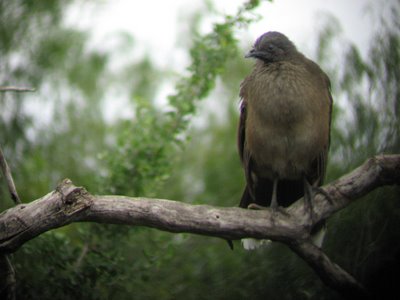Kudos to
Jody Hildreth for winning this month's fiction contest! He now gets to choose two recently published bird books from the
WildBird bookshelves.

If you'd like to earn that opportunity, then write an original 500-word short story about birds, birding or birders that includes a setting, a character or characters, a conflict and a resolution. Also, the birds cannot be anthropomorphized.
Many thanks to this edition's participants! I hope that you'll submit stories for the December edition. The deadline is
Nov. 29.
Now, for your consideration: "Cowbird Conundrum" by Jody Hildreth.
Walking in a springtime forest opens your eyes to new experiences, especially when taking a 5-year-old. Aubrey was a child that loved to investigate and wasn’t afraid to pick up a six-legged creature for closer examination. It was only a five minute hike to our favorite resting spot: a large boulder which was surprisingly comfortable to lounge on.
I immediately rested when I came to the ancient chair, but Aubrey was full of energy. She dug in the leaves, went face first into a spider web without a shriek, and then climbed our rock as though it were Mount Everest.
"Daddy, look!" she fiercely whispered. She was pointing to a nest only twenty feet away. We saw no bird, so I suggested we sit quietly and wait. This would put my little birder to the test. After a long silence and some anxious wiggles, something landed near the nest. The branch it was built on bounced ever so slightly.
"Daddy!"
"Shhhh," I replied. "Know what kind it is?"
"No," was the muffled reply.
I told her it was a Red-eyed Vireo and that when we got back to the house, we could look it up in her field guide and listen to it on the computer. That wasn’t enough, however, for this inquisitive girl. She knew that a nest had eggs, and she wanted to see them. I awkwardly put her up on my shoulders, which also scared away the bird. Standing under the nest, I told her to pull the branch down just enough to look inside.
"Daddy, there’s four eggs," she chirped.
"What do they look like?" I asked.
"They’re pokey-dotted," came the reply. "And one is bigger."
Oh no. A cowbird egg. What to do. I told her that cowbirds are terrible birds that are bigger than the parents that raise them. I explained that it’s not right for the vireo to raise such an ugly bird and told her to take the egg out of the nest.
She slid off my back with the egg held safely in her cupped hands.
"Can we hatch it?" she asked. I explained that we couldn’t for several reasons.
"But what’s gonna happen to the birdy inside?" she asked.
I told her it just wouldn’t grow.
There was a long silence as Aubrey stared at that egg, and I watched it roll around in her tiny hands. Then she looked up at me and said, "But Daddy, I look different from you. Shouldn’t someone be this bird’s mommy?"
I couldn’t speak, but I did nod my head quickly. I held the egg as she hopped on my back, and together we got the egg back in place.
Yes, my adoptive daughter taught me a valuable lesson that day. That cowbird would grow because it had parents that would care for it, even if it did look different. I know, because together, we watched that baby cowbird every morning until it left the nest.














































